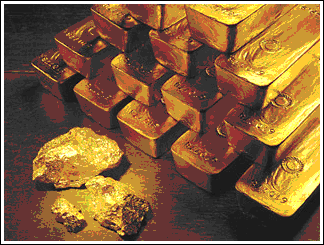Blood and Gold
Welcome to the Democratic Republic of the Congo, the warzone that helps make your iPhone.
MAY 12, 2011
Mining is big business in the Democratic Republic of the Congo, and it is at the forefront of the global debate over how to end the violence in this war-torn country. Congo’s riches, including enormous deposits of gold, diamonds, copper, and cobalt, may not have initially instigated that country’s decades of war, but they definitely are keeping the battle raging, 8 years after the war was officially declared over.
Above, a worker stands on a mound of dirt at an abandoned industrial mine on March 28, 2006, in Mongbwalu, in Congo’s volatile northeast corner.
Spencer Platt/Getty Images
Men sift through buckets of dirt while looking for gold in Mongbwalu. 11,000 pounds of gold are mined annually in eastern Congo. Gold fetches about $15,000 per pound on international commodities markets, generating huge profits for the armed groups that control the majority of mineral mines in eastern Congo, often forcing local villagers to work for them. In 2008, these groups earned an estimated $50 million from the mineral trade.
Spencer Platt/Getty Images
Workers dig at a gold mine on Feb. 23, 2009 in Chudja, in northeastern Congo. 5.4 million people died due to fighting and humanitarian crisis in the Congo from 1998 to 2008, and about 45,000 more are killed every month, according to the International Rescue Committee. This is the highest death toll from a single conflict since World War II.
LIONEL HEALING/AFP/Getty Images
A man stands in a pool of water at the Chudja gold mine. Congo’s mineral wealth doesn’t end with gold. The country has about 4 percent of the world’s copper and a third of its cobalt. And the mining industry is growing. In 2009, Congo produced 300,000 metric tons of copper. By 2015, that amount is expected to increase to 1.9 million tons.
LIONEL HEALING/AFP/Getty Images
A boy rests next to his battered bicycle after riding nearly 50 miles along dirt roads in Mongbwalu. Congo has virtually no paved roads — a 50-mile trip can take up to seven hours by car, isolating communities across the country. The government has recently begun a five-year, $600 million renovation of its rail lines to help develop the mining industry.
Spencer Platt/Getty Images
Men dig through dirt and mud while looking for gold at the abandoned industrial mine in Mongbwalu. Thousands of Congolese scrape together meager livings from mining. Despite Congo’s mineral wealth, the country is $13.5 billion in debt, and 71 percent of the population lives below the poverty line.
Spencer Platt/Getty Images
A man pushes his motorcycle up a dirt road in Mongbwalu.
Spencer Platt/Getty Images
A young boy takes a break from mining gold at Mongbwalu.
Spencer Platt/Getty Images
Men work at the Chudja mine.
LIONEL HEALING/AFP/Getty Images

A local miner breaks up rocks in a gold mine near Mongbwalu.
LIONEL HEALING/AFP/Getty Images
Mongbwalu miners walk home along a dirt road.
Spencer Platt/Getty Images
Men mine for gold on March 27, 2006, in Mongbwalu. Working in mines is dangerous, and workers are poorly compensated. For example, the diamond industry is worth about $900 million annually and provides work for 1 million people, but many diggers earn less than $1 a day.
Spencer Platt/Getty Images
Children play on the streets of Mongbwalu. 42 percent of Congolese children aged 5 to 14 are child laborers.
Spencer Platt/Getty Images
A Mongbwalu boy mines for gold.
Spencer Platt/Getty Images
A woman carries wood along a dirt road in Mongbwalu. The shocking statistics on rape and violence in the Congo — 48 rapes occur each hour — have attracted international attention, including boycotts by many U.S. companies of Congolese minerals. But there has been little concrete action from the U.S. government, other than the State Department allotting $17 million for medical care, legal support, and counseling for rape victims. All of this may simply push Congo closer toward trading partners like China (which signed a $9 billion “ore-for-infrastructure” deal with Congo in 2008) who may care less about human rights and corporate social responsibility.
Spencer Platt/Getty Images














